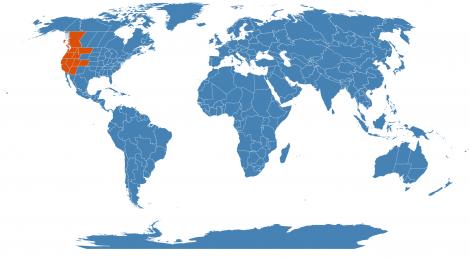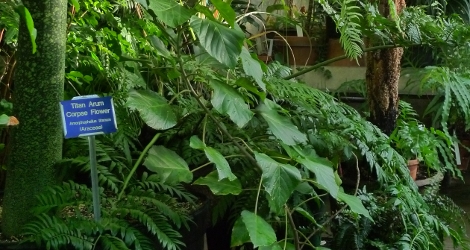Accession Data:
Holodiscus discolor (Pursh) Maxim.
- Common Name: Ocean Spray, Creambush
- Family: Rosaceae Juss.
- Country of Origin: western North America

- Habitat: openings and the forest understory at low to moderate elevation
- Description: Holodiscus discolor is a fast-growing deciduous shrub growing to 5 m tall. Its alternate[6] leaves are small, 5–9 cm long and 4–7 cm broad, lobed, juicy green when new. Cascading clusters of white flowers drooping from the branches give the plant its two common names. The flowers have a faint sweet, sugary scent. It bears a small, hairy fruit containing one seed which is light enough to be dispersed by wind.2
- Uses: Historically the plant has been used for many purposes. The Lummi used the flowers as an antidiarrheal and the leaves as a poultice. Many other tribes used the wood and bark for making tools and furniture. Noted for the strength of its wood, it was often used for making digging sticks, spears, arrows, bows, harpoons and nails. The wood, like with many other plants, was often hardened with fire and was then polished using horsetail. Several Native tribes, such as the Stl'atl'imx, would steep the berries in boiling water to use as a treatment for diarrhea, smallpox, chickenpox and as a blood tonic.2
- USDA Zone: 5-10
Accession Data:
- Accession # 201600040
- Source: Forest Farm
- Accession Date: 04-14-2016
- Bench: 6999 - BPB Greenhouse Corridor
- Currently: active - healthy
- Qty: 1 confirmed on 08-28-2018
Classification:
- Division: Magnoliophyta
- Class: Magnoliopsida
- SubClass: eurosid I
- Order: Rosales
- SubOrder:
- Family: Rosaceae
- SubFamily: Amygdaloideae
- Tribe: Spiraeeae
- SubTribe:
References (internal):
- EEB Greenhouse Holdings native to: British Columbia / Colorado / Idaho / Montana / Oregon / Washington / Arizona / California / Nevada / Utah
References (external):
- The Plant List (2013). Version 1.1. Last accessed on Thursday, April 14, 2016.
- Holodiscus discolor at Wikipedia. Last accessed on Thursday, April 14, 2016.
data regenerated on Tue, 23 Jul 2019 08:20:53 -0400 [bcm v4.0]
Images:

Additional images for this accession:
Click on thumbnails to enlargeCurrent Accessions in the Rosaceae
Subfamily Amygdaloideae
Tribe Amygdaleae
Subfamily Amygdaloideae
Tribe Maleae
Subfamily Amygdaloideae
Tribe Spiraeeae
Subfamily Dryadoideae
Tribe Dryadeae
Subfamily Rosoideae
Tribe Colurieae
Subfamily Rosoideae
Tribe Potentilleae
- Fragariinae: Duchesnea indica

- Fragariinae: Fragaria chiloensis W/C


- Potentillinae: Potentilla rhenana


Subfamily Rosoideae
Tribe Rubeae
Subfamily Rosoideae
Tribe Sanguisorbeae
- Agrimonilinae: Agrimonia eupatoria

 = indicates flowering in past 14 days
= indicates flowering in past 14 days
 = images available for this accession
= images available for this accession
 = map available for this accession
= map available for this accession
 = accession added within past 90 days
= accession added within past 90 days